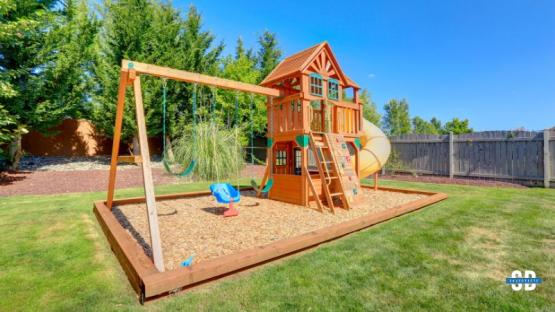Whether you’re designing a backyard playground for your home, a school, or a commercial space, you want its usefulness to last. Unfortunately, many parents, educators, and planners underestimate â or don’t consider âthe factors that impact longevity. Of course, you want durable structures that will stand the test of time without falling into disrepair. However, what happens when it’s the kids, not the playground equipment itself, that ages out as the years pass?
In order to build a backyard playground with a truly lasting impact, you have to design for a longer life cycle. You have to think beyond just what your kids will want when they’re young, and even consider their teen years and beyond. At the same time, you can’t go too big or ambitious, or you risk scaring off the youngest users. Here’s how to design a backyard playground that grows with your kids at any developmental stage or life season.
Choose Timeless Classics
It can be tempting to latch on to the trends of the season, like theme sets designed for a particular movie or superhero franchise. However, as much as your kids say they’ll love Frozen or Deadpool forever, they could be on to the next thing within a few months. When you’re choosing playground elements, aim for timeless classics kids (and adults) will love throughout the year. For inspiration, consider your own backyard favorites and what they mean to you.
For example, swing playground equipment , slides, and monkey bar sets almost never go out of style. Admit it: when you take your kids to the playground, you often wish you could be the one to play instead of push. Even in your 50s, 60s, and 70s, it’s tempting to take a little swing or see if you’ve still got the arm strength for a pull-up. Your kids are going to feel the same way, so invest in those playground components that never get old, even as you and your kids do.
Use Quality Materials
In order for the classics, or any other playground equipment to last, it’s essential to choose the right products. You’ll want to invest in high-quality, durable equipment built from materials made to last decades. Of course, it can be tempting to cut corners in order to give your young children a plethora of features and experiences to play with. However, that won’t feel so important within a few months or years, when you’re up to your neck paying for repairs.
As you choose your playground components, be sure to consider the long-term maintenance costs â and the time you’ll spend on the phone. While flashy plastic parts can look fun, you and your kids might ultimately be much happier with a sturdy workhouse of a play set. Meanwhile, the wrong playground pieces can quickly turn into sources of stress â or even danger â for your household. Always prioritize safety and quality over short-term novelty or cost savings.
Start Small and Go Modular
You don’t have to buy the whole playground at once; you can start with something simple like a set of swings or small jungle gym. As your kids grow, or as you save up, you can keep adding on and introducing more age appropriate components. Some playground sets are built as modular components, intentionally designed to be connected together. Otherwise, you can simply clear more space in the yard and add each new playground piece next to the old as you go.
Either way, you’ll want to add a range of experiences with different interactive features for a variety of developmental stages. It’s also a good idea to include components that are both intellectually and physically stimulating. When the kids are young, you can start with slides, nets, and other simple playground classics. As they get older, try incorporating more “grown up”; features like climbing walls, exercise equipment, and other elements made for teens and adults.
Factor in Accessibility
Not to be bleak, but if someone in your family experiences an injury or disability â either parent or adult â you want to be ready. Plus, as you age, your capacity to play with your kids may change with your joints or other natural age-related progressions. It’s crucial, therefore, to design your playground around the potential need for increased accessibility. That might mean considering adaptive swings, wheelchair-accessible ramps, or features for hearing or vision loss.
Remember, disability and chronic illness can impact anyone at any age. Plus, you never know who your kids might bring home that might also want to use the playground equipment. Your best bet for a long-lasting playground investment is to design for as many people as possible. Inclusive design features mean that your playground can stay relevant and usable, regardless of what’s in store for your family’s future.
A Playground That Evolves With You
Done right, designing a backyard playground can be a real investment in your family’s future. It can be a tool for fun, healthy development, creativity, intellectual stimulation, and building good fitness habits. The trick is to consider long term needs over short term impulses or unnecessary add-ons. To build a playground that sticks around, think about quality and diversification. Choose a variety of well-made, long-lasting components to suit all ages, interests, and abilities.







